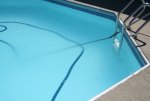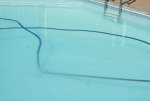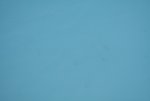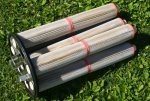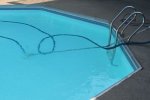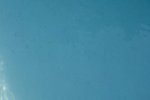Guess I should rephrase my question.
Based on the numbers on the No-SWG chlorine target chart in the pool school, CYA to Target FC, what could one reasonably expect to loose in say, one hour of direct sun?
Example: CYA of 30 with Taget FC of 4 and everything else also at target.
The reason I ask is because, the past two days, if my FC drops below 20, my CC is 0.
Above 20, then CC is .5, which indicates to me that there is still stuff in my pool, as it's not clear yet.
It also suggests that the CYA that I added last week is finally "present" and would give me a reading if I had the regent to test it. I am waiting for that delivery.
During the daytime, with full sun on my pool, my FC drops 2ppm every hour, sometimes more. Overnight, it's been dropping significantly. Last night shows a FC drop of 6 in a 7 hour period. Would this happen if their really were a high amount of CYA in the pool? or ANY CYA in the pool?
I cannot currently test for CYA. Waiting for regent order to arrive. My own tests last week when I had some, where reading a half sized dot in a full tube, yet the store test the week before said it was 20. So I really have no idea right now how much is in there. If there is none, then high FC losses, daytime or nightime, make sense. If there IS some, then high FC losses especially at night don't make sense to me. Some of my chlorine should be holding, should it not? The pool is blue, can see bits of dark stuff here and there on the bottom, which I think drops down there after I have already vacuumed. However the water is not clear enough to see the design on the floor of the pool.
Based on the numbers on the No-SWG chlorine target chart in the pool school, CYA to Target FC, what could one reasonably expect to loose in say, one hour of direct sun?
Example: CYA of 30 with Taget FC of 4 and everything else also at target.
The reason I ask is because, the past two days, if my FC drops below 20, my CC is 0.
Above 20, then CC is .5, which indicates to me that there is still stuff in my pool, as it's not clear yet.
It also suggests that the CYA that I added last week is finally "present" and would give me a reading if I had the regent to test it. I am waiting for that delivery.
During the daytime, with full sun on my pool, my FC drops 2ppm every hour, sometimes more. Overnight, it's been dropping significantly. Last night shows a FC drop of 6 in a 7 hour period. Would this happen if their really were a high amount of CYA in the pool? or ANY CYA in the pool?
I cannot currently test for CYA. Waiting for regent order to arrive. My own tests last week when I had some, where reading a half sized dot in a full tube, yet the store test the week before said it was 20. So I really have no idea right now how much is in there. If there is none, then high FC losses, daytime or nightime, make sense. If there IS some, then high FC losses especially at night don't make sense to me. Some of my chlorine should be holding, should it not? The pool is blue, can see bits of dark stuff here and there on the bottom, which I think drops down there after I have already vacuumed. However the water is not clear enough to see the design on the floor of the pool.



